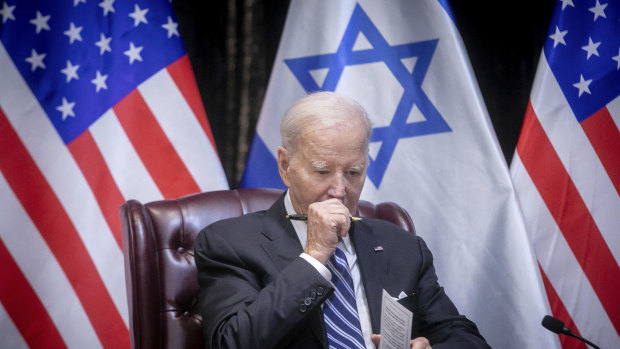This was published 9 months ago
Opinion
Middle East conflict could stretch to China and Russia, if Biden’s not careful
Amin Saikal
Professor of Middle Eastern, Central Asian and Islamic StudiesThe oil-rich but conflict-ridden Middle East is in transition from its old volatile conditions to a new unpredictable posture. If the transition is not managed responsibly by regional and major powers, the US in particular, a conflation of the old and new fault lines carries the potential to widen and deepen the region’s paradigm of volatility.
The ongoing Gaza war has proved to be a major catalyst in the process, sparked by Hamas’s appalling 7 October attacks on Israel and enlarged by Israel’s devastating invasion of Gaza. Consequently, the war has brought Israel and the United States into a potentially direct confrontation with their long-standing adversary, the Islamic Republic of Iran, and its affiliates in the region.

Major world powers, in particular the US, are needed in to achieve peace in the Middle East.Credit: AP
Publicly, both sides have projected disinterest in an expansion of the Gaza conflict, but neither wants to lose the war, even if it carries the risk of a regional confrontation, and so, they have engaged in a tit-for-tat military exchange beyond Gaza to achieve their objectives.
Israeli Prime Minister Benjamin Netanyahu, who is legally besieged by charges of fraud, has shown a steely determination not only to flatten the Gaza Strip at the cost of unprecedented carnage in the Middle East, but also to tighten control over the occupied West Bank. He has also displayed a strong desire to extinguish any threat from the Iran-backed Lebanese militant group Hezbollah, the Syrian regime, and Shia militias in Syria and Iraq. These forces, along with the Houthis in Yemen, form the “Axis of resistance”, or what Israel and its main international backer, the US, call an “axis of evil” that supports the Palestinian cause. President Joe Biden’s administration has shared this perspective, and to date, has failed to exert sufficient pressure on Israel to agree to a ceasefire and thus prevent the conflict from spreading.
In recent weeks, to Tehran’s profound irritation, Israel has taken actions that include killing the deputy leader of Hamas and a senior Hezbollah commander in Beirut, and an Iranian general in Damascus. These targeted assassinations have signalled that Jerusalem favours a widening of the conflict so as to draw Iran – an “existential threat” to Israel – into a confrontation, in which the US fully supports Israel.
On the opposite side, Iran has relied mostly on its affiliates to protect its interests. Hezbollah and the Houthis, as well as other proxies, have actively supported Hamas and the Palestinian cause. Tehran has dwelt on the spectre of Israel exhausting itself in Gaza and diminishing its international standing, along with that of the United States, given Hamas’s resilience and the Gazan carnage.
Tehran has, meanwhile, prepared for any spread of the conflict at a time when its regional position is relatively strong along with the strength of its regional network of affiliates and close relations with Russia and China.
It would be unthinkable to imagine that Tehran does not coordinate with Moscow and Beijing in calculating its regional strategy. In any direct clash with Israel or the US or both, Tehran can be expected to count on diplomatic and material support of these American global adversaries. This is an issue that the Biden leadership cannot afford to ignore when considering its options for the length of time and support that it can give to Israel.
This week, in a show of force and revenge and for the first time since October 7, Tehran acted directly against Israeli and US interests by targeting the Israeli spy agency Mossad’s compound and the US consulate in Erbil, the Kurdistan region of Iraq, using long-range missiles. Through these actions, Tehran has sent a clear warning that it is not afraid of the current climate.
Whatever transpires in the weeks ahead, the Gaza war has changed the strategic landscape of the Middle East. Israel has been isolated, and mistrust for the United States has escalated throughout the region.
While many autocratic Arab governments still find it expedient to conduct their relations with the United States above and beyond this war, the same is not true of the Arab streets where Hamas and its regional supporters have reportedly gained unprecedented popularity, which is very much reminiscent of the popularity Hezbollah gained after successfully resisting Israeli operations in 2006. Now, the Islamic Republic of Iran, has been availed a unique opportunity to share a common anti-Israel and anti-US cause within the Arab/Muslim domain.
With the threat of a regional conflagration looming, the Middle East is in the grip of a more consequential crisis than any before it. The situation urgently demands the prevalence of sober thinking and the avoidance of miscalculation on the part of all parties involved.
A wider conflict could produce an uncontrollable inferno. An immediate ceasefire in Gaza is required as the first step, leading to a negotiated settlement of the Israeli-Palestinian conflict within a two-state solution, to pull the region back from the brink.
Amin Saikal is emeritus professor of Middle Eastern and Central Asian Studies at the Australian National University, and adjunct professor of social sciences at the University of Western Australia. He is the author of How to Lose: the story of America’s intervention in Afghanistan, due for release in June 2024.